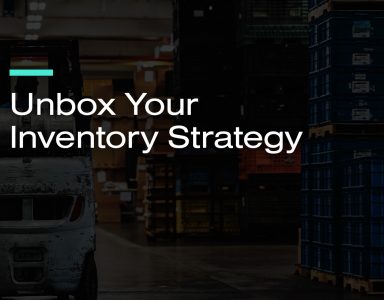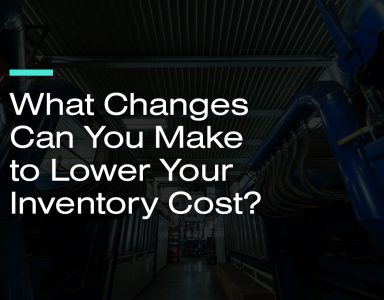
We all know what to do and what not to do. The key is to develop a plan—and stick to it.
A new year is upon us and you may have made a personal resolution to get in better shape. You may also have a professional goal to reduce your inventory levels. And if you think about it, the similarities between these two goals are uncanny.
Both require you to do the right thing, every day. In terms of health, it means eating right and getting into a fitness routine. With inventory management, you may know what to do in a general sense but you’ll need a plan to encapsulate your strategy and provide direction. If you change habits and keep taking steps toward your goal, you’ll achieve success. How much and how soon is not so easily predicted. Nor does it matter. It’s sticking to the behavioral changes that’s key.
Develop a Plan, Stay Disciplined—But Also Update as Necessary
So, about that plan…any inventory optimization plan is only as good as the forecast and demand plan over the same rolling time horizon. How much confidence do you have in your forecast for this same month one year in the future? Aggregate forecasts are more accurate than individual item forecasts, but there is still a measure of uncertainty when looking out 18 months, or 12 months, or even 6 months. The inventory plan can’t be better than the demand plan accuracy—and the further out, the lower the accuracy.
And what about the supply plan? Your supply plan may be based on current fuel prices, equipment availability, factory capacities, and product mix. Do you think those factors might change over 18 months? The question still stands: How accurate and meaningful is an optimized inventory plan that’s projected out 8, 12, or 18 months?
When you’re eating right and exercising, you’re sticking to your plan—but life happens. You’ve got your nephew’s birthday party which will include pizza and cake. Or, you had planned to run 3 miles every day around your neighborhood but there’s a bizarre cold snap in your area—with temperatures as low as 10 degrees below zero. What are you going to do now? If you did a “forecast” that accounted for these possible stumbling blocks, you can work around them while still sticking to your plan.
The same holds true with the goal of reducing inventory levels. Developing the best forecast and demand plan possible then continually updating that plan on a rolling 12-month or longer basis means you can respond to changes faster. You’ll need to make sure our data is being properly managed and updated including lead times, capacities, and run rates that accurately reflect reality. This also applies to safety stock, re-order points, and other controls that drive the planning process, which should also be reviewed and updated on a regular basis.
And like when you’re focusing on losing weight and getting healthier, you’ll need to be disciplined and follow the plan to optimize inventory. Concentrate only on the exceptions and follow the system recommendations as much as possible. It’s only the changes in procedure that drive the change in results.
Albert Einstein once said, “Insanity is doing the same thing over and over and expecting different results.” You can’t keep eating chocolate cake for dinner and sitting on the couch and expect to get healthy. Likewise, your optimized inventory plan predicts improved results but you can only achieve them by carrying out the recommendations embedded in the plan.
When you’re sore from doing too many crunches or craving a cupcake (or two), you need to stay focused on specifics. How do you want to feel? How do you want to look? Visualize that end goal in as much detail as possible. Being vague won’t help you when your will is being challenged because the cupcakes will win every time.
Reducing your inventory won’t happen either if you leave it up to the vagaries of supply and demand variability. Successful execution of your optimized inventory plan means constantly measuring and tracking:
- Forecast accuracy to characterize the risk of uncertainty so you can manage that risk. Also, measure or progress toward improved forecasts.
- Customer Service KPIs to make sure any inventory reduction or redeployment is improving customers service. Look at such measures as Case Fill, Line Fill, Complete orders, On-Time Shipments
- The same Service KPIs for Suppliers of raw, pack, and finished goods. Manufacturing schedule adherence is the equivalent measure for our “internal” supplier.
Also remember that the plan is only as good as the data it is based on. On a periodic basis, be sure to measure and track:
- Lead times
- Capacities
- Run rates
- Inventory
- Safety Stock levels and re-order points
- Customer data
- New Product dimensions, weights, units of measure
Measure and track your official corporate measures monthly and quarterly as required. Most companies watch some combination or variation of these:
- Total inventory investment and sub-category investment (raw materials, WIP, finished goods, by market, or product line)
- Inventory as a percent of sales
- Excess and obsolete inventory value
- Inventory turns
- Days coverage
As inventory begins to come down and service rates improve, management will naturally want to know where these statistics will be over the next year or so. You can make a projection when you have enough data points to do so.
Focus on Continuous Improvement as Your End Goal
Achieving inventory optimization can mean very different things in specific companies and markets. In truth, inventory optimization may be a goal that you work toward but never actually achieve. If you are in fact fortunate enough to actually achieve it, it will likely be only for an instant. Then something changes.
Something always changes, so it’s best to treat inventory optimization as a continuous improvement effort and monitor the KPIs along the way—just as you will weigh yourself regularly to monitor your weight loss progress. Maintaining optimum health and weight involves a lifestyle change. Inventory optimization is similar since it requires a shift in how you do things as well (remember Einstein’s thoughts above).
If you are ready to get your inventory in shape, DemandCaster supply chain planning software can help you create an optimization plan using data-driven insights—and execute on that plan while you monitor KPIs for ongoing success.


